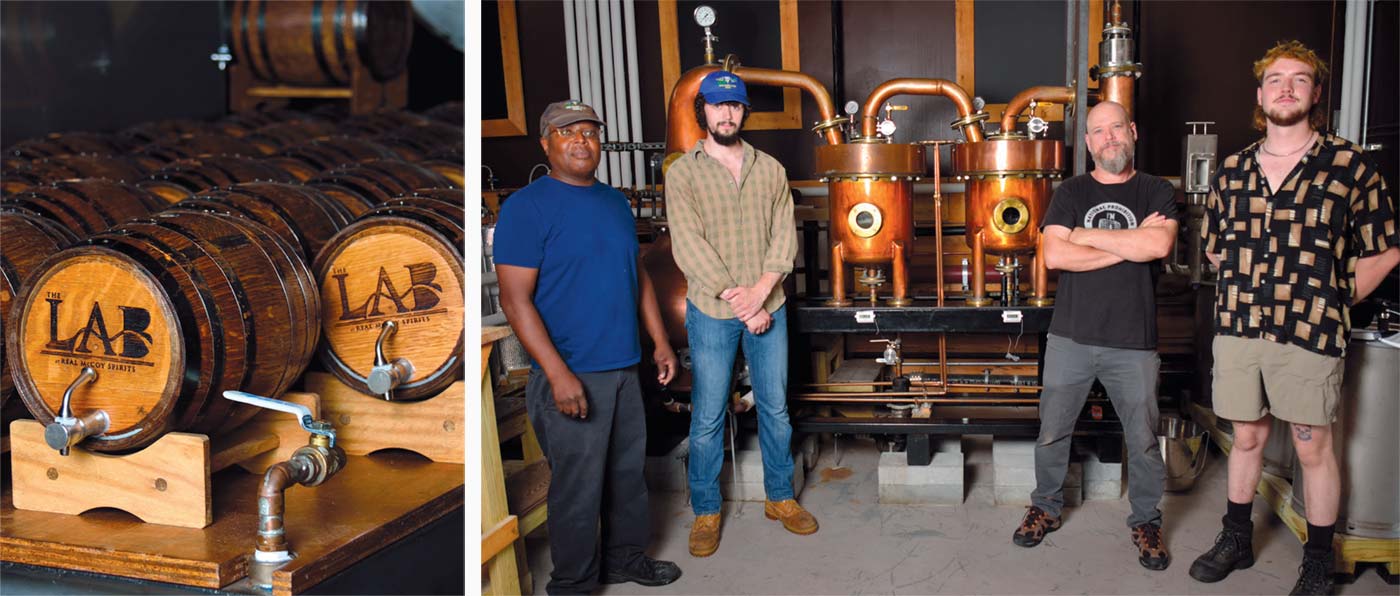Real McCoy Spirits is Distilling Tradition
A century ago, ship builder turned gentleman rum runner Bill McCoy made a name for himself by selling smuggled alcohol from his ships just outside the US border in international waters. Importantly, while competitors were diluting their alcohol to extend profits, Bill sold only pure, undiluted product including rums, whiskies, fine liquors, and wines that quickly gained fame. In doing so, Bill’s quality spirits, and in fact Bill himself, became known as The Real McCoy.
More than a little fascinated by the story, Mystic documentary filmmaker Bailey Pryor immersed himself in the legend and the man behind it. He had no idea, however, that going down the rabbit hole for his film about Bill McCoy, the face of rum running one hundred years ago, would take him from behind the camera to inside the copper walls of his very own distillery. His film, The Real McCoy Documentary, of 2012, went on to win five Emmys, and sent Bailey and his family on a quest to learn more about the product and the myth behind such a legendary name.
Bailey was surprised to learn that the phrase “ The Real McCoy,” one that many of us have likely used on more than one occasion, had never been trademarked. Furthermore, he discovered there were no rum distillers in the U.S. market using the same methods McCoy employed a century ago when he created the unadulterated rum that made him so trusted during prohibition. So, Bailey wisely trademarked the name and sought out the rum that Bill made famous.
First stop for the filmmaker was Barbados, birthplace of rum. Bailey's search led him to Four-Square Distillery, founded in 1737, and 4th generation master distiller Richard Seale. They formed a partnership to keep the traditions alive and Bailey went to Barbados to start a nearly decade-long apprenticeship with Richard. Their goal was to celebrate the classic Barbados style of rum production, family history, and the meaning behind the man, Bill “ The Real” McCoy. The result was the launch of e Real McCoy brand of rums, with no added flavors, perfumes, or dyes; just natural ingredients, open air, small batches, a column and pot still distillate, and aging–time spent in American oak, ex-bourbon barrels.
Following the success of The Real McCoy brand, Bailey was now committed to distilling all manners of spirits so he continued his education. He completed an apprenticeship in Martinique, specifically learning methods for Rhum Agricole (the French Caribbean process which relies on sugar cane juice rather than molasses); as well as an apprenticeship in Scotland (where the one-of-a-kind Real McCoy two-pot still was procured) discovering all he could about Single Malt Whiskey.
Today, at Real McCoy Spirits (RMS), the research never ends, which is why their location in Stonington is called The Lab, not a distillery. “The Lab allows the company to do just what is meant to do for experimentation and discovery. Trial and error, small batches, low waste,” says Bailey. They focus on the slow development of rum based ready to drink (RMS) cocktails, as well as beer and a range of spirits including whiskies, gin, and vodka. They’re set up to take their time to ensure the best results.
Keeping up the pattern of stepping back in time, Bailey and the RMS crew work with Thrall Family Malt out of Windsor in Hartford County, a farm that dates to 1646. Thrall originated as a small-crop farm, soon pioneering the state’s shade tobacco industry. Still run by the Thrall family today, the company supports numerous craft brewers and distillers across the state.
The Lab is also a place where those in the local restaurant and beverage industry can visit to really understand the process behind the product before adding RMS products to their bar program. The goal is to scale up in the future, but for now, the crew manages the process on a level that keeps them directly connected to every still, barrel, or pour without compromising taste, cost, or ultimately their brand.

The one-of-kind Real McCoy two pot still
One of the ways RMS is managing their connection to today’s growing interest in spirits and what’s behind them is with Bailey’s son Finn Pryor, distiller and product developer. Carrying an almost encyclopedic torch from his father, Finn took us on an informative tour, along with operations manager Damien Rocherolle, head brewer Joel Johnson, and apprentice Jake Raggon to demonstrate the process of their unique two copper pot distilling system, barrel aging system, to RTD mini cocktail barrels Finn has helmed, especially for Mystic’s ever popular and growing culinary and cocktail scene.
Most recent on the scene is the unique, cocktail forward hotspot, Port of Call, where Chef Renee Touponce and Beverage Director Jade Ayala of Oyster Club have flipped the switch on dining using cocktails as the driving force behind the culinary experience. Finn recalls, “Jade came and spent three days at The Lab, testing various ways to present specialty drinks, including the Curry Barbados.” The drink uses The Real McCoy 3-Year Aged Rum, Curry, Ginger, Lime, Bitter Chocolate, and Fennel Bitters. “But you can use pineapple bitters, for example, and take the cocktail in a whole new, more floral or sweet, direction,” Finn explains. The RTDs have become a bartender’s toolkit, giving mixologists a foundation from which they build their own unique program while keeping up with capacity and demand for high quality ingredients. The RTDs are proving to be both exceptional new drinks as well as time and cost savings for busy bars.
The Lab is continuing the experimentation into a successful small batch whiskey and gin program where there’s a lot of wait and see. Most recently, they are reaping rewards from their beer program, wherein, like the rum making, there are no additives or chemicals pumped into to speed up fermentation. Currently, there are two barrel-fermenter tanks, however the goal is to one day have 30. With the current format and size, Bailey explains, “Our system is a great opportunity to experiment, but not have a negative impact on the environment. If we don’t like it, we don't have the economic pressure to sell. We only release what we really like, it’s why we call this the Lab!”
Bailey continues, “We’re just about a year into the beer program, and head brewer Joel is just killing it. “We employ a natural beer process with no anti foaming agents sprayed into the tanks to keep the foams down; there are no additives of any kind, and there’s no dextrose added to get the alcohol content up. It’s about 5.5-6 ABV. Everything is naturally carbonated. We let it go naturally. For us it takes three weeks to lager and carbonate naturally, longer than most.” They have found three weeks to be the sweet spot in terms of taste, carbonation, alcohol content, while keeping up with capacity.
No longer on the edge of the law, but just as remarkable, Bailey Pryor and the Real McCoy Spirits crew are reaching back in time to supply a high-quality product in full view for all to see, consume, and enjoy.
- More at realmccoyspirits.com

(left) Ready to drink spirits ready for use in distinctive casks; (right) From left - Joel Johnson - Head Brewer, Jake Raggon - Apprentice, Damien Rocherolle - Operations Manager, Finn Pryor - Distiller/Product Developer
TRADITION EXPLAINED BY FINN PRYOR, REAL MCCOY SPIRITS DISTILLER/PRODUCT DEVELPER
“The modus operandi of The Lab is traditional, unadulterated production methods - the idea is our products are made the same way they would’ve been 200 years ago on the back of a stillman’s wagon.
It all starts with Mashing: We use heritage Connecticut grain, mill it and mash-in with well water.
After mashing is complete and the “wort” is cooled we pump it across to open-top wooden fermenters called wash backs.
The open-top format allows local microflora and bacteria into the fermentation which leads to development of congeners and a flavor profile specific to our local.
Once that wort has fermented - the yeast has converted the fermentable sugars into alcohol and CO2 - we end up with a barley “wine” at 8-9% alcohol.
That wine is then pumped across to our double-retort copper pot-still where it is distilled into whiskey.
We make our cuts and take the “hearts” cut to the blending tank where it is diluted to cask-strength and prepared for aging.
We split up our spirits between 7 different types of casks: Ex-Bourbon, Ex-Rye Whiskey, Virgin Oak, Ex-Port, Ex-Madeira, Ex- Sherry and our Real McCoy Rum casks from Foursquare Distillery, then the wait begins. This variety of casks allows us to experiment with how our spirits behave not only over time, but also between each type of cask and each use.
Overall, this research and development layout allows us to experiment, make mistakes and learn all in the name of making a traditional, beautiful product.”





